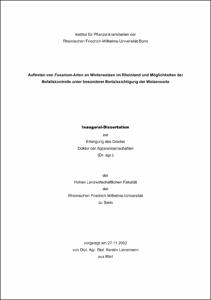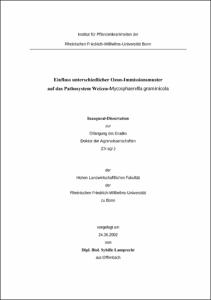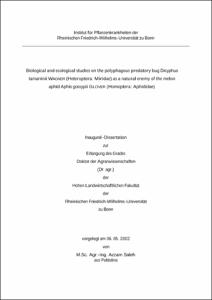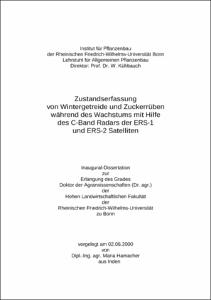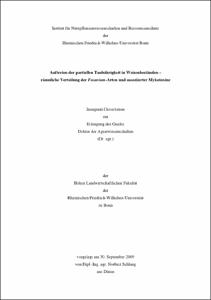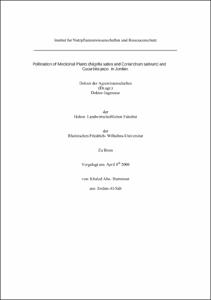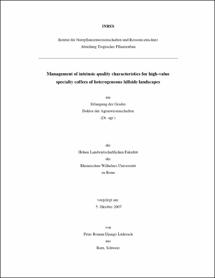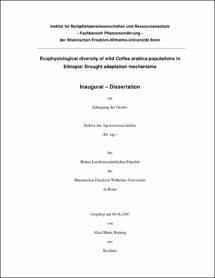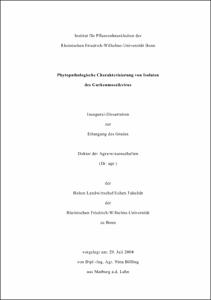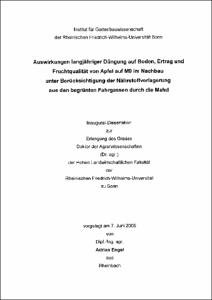The Faculty of Agricultural, Nutritional and Engineering Sciences: Search
Now showing items 1-10 of 58
Auftreten von Fusarium-Arten an Winterweizen im Rheinland und Möglichkeiten der Befallskontrolle unter besonderer Berücksichtigung der Weizensorte
(2003)
In den Jahren 1998 - 2000 traten im konventionellen und ökologischen Weizenanbau Ährenfusariosen in Abhängigkeit von Jahr, Witterung, Standort und Weizensorte in erheblichem Maße auf. Der Kornbefall mit Fusarium spp. ...
Einfluss unterschiedlicher Ozon-Immissionsmuster auf das Pathosystem Weizen-Mycosphaerella graminicola
(2002)
Weizenpflanzen wurden in Klimakammern bei unterschiedlichen Ozon-Immissionsmustern exponiert und der Einfluss der Schadgasbelastung auf das Pathosystem Weizen- Mycosphaerella graminicola untersucht. Die Wirkung eines ...
Biological and ecological studies on the polyphagous predatory bug Dicyphus tamaninii WAGNER (Heteroptera: Miridae) as a natural enemy of the melon aphid Aphis gossypii GLOVER (Homoptera: Aphididae)
(2002)
The present research aimed to study the biology and prey consumption by Dicyphus tamaninii WAGNER (Heteroptera: Miridae) by feeding on different age groups of Aphis gossypii GLOVER (Homoptera: Aphididae) as ...
Zustandserfassung von Wintergetreide und Zuckerrüben während des Wachstums mit Hilfe des C-Band Radars der ERS-1 und ERS-2 Satelliten
(2000)
Ein wesentliches Ziel der Fernerkundung in der Landwirtschaft ist die Inventur der Bodennutzung. Optische Sensoren lieferten bereits gute Ergebnisse der Klassifizierung und der Abschätzung der Pflanzenvitalität über den ...
Auftreten der partiellen Taubährigkeit in Weizenbeständen – räumliche Verteilung der Fusarium-Arten und assoziierter Mykotoxine
(2010-01-07)
In den Jahren 2006 und 2007 wurde die räumliche Verteilung von Fusarium spp. und assoziierter Mykotoxine in natürlich infizierten Weizenfeldern auf der Regionalebene und auf der Bestandesebene untersucht. Auf der Regionalebene ......
Occurrence of Fusarium head blight in wheat fields - spatial distribution of Fusarium species and associated mycotoxins
Investigations into the spatial distribution of Fusarium spp. and associated ......
Occurrence of Fusarium head blight in wheat fields - spatial distribution of Fusarium species and associated mycotoxins
Investigations into the spatial distribution of Fusarium spp. and associated ......
Pollination of Medicinal Plants (Nigella sativa and Coriandrum sativum) and Cucurbita pepo in Jordan
(2008)
The aim of this doctorate thesis was to reveal the reproductive system and to identify the main pollinators in Jordan of Black Cumin (Nigella sativa) Coriander (Coriandrumer sativum) and squash (Cucurbita pepo). These ......
Pollination auf medizinische Pflanzen (Nigella sativa und Coriandrum sativum) und Cucurbita pepo in Jordanien
Eines der Ziele der vorliegenden Arbeit war, die Bienenfauna und ihre Trachtpflanzen ......
Management of intrinsic quality characteristics for high-value specialty coffees of heterogeneous hillside landscapes
(2007)
Tropical hillsides are ecologically and socially diverse with a multitude of small- to medium-sized farms that offer a potential treasure chest of high-value market crops. Specialty coffees, for example, earn a substantial ...
Ecophysiological diversity of wild Coffea arabica populations in Ethiopia: Drought adaptation mechanisms
(2007)
Drought is a wide-spread limiting factor in coffee (Coffea arabica L.) production, but the development of adapted cultivars is hampered by a limited understanding of the physiological resistance mechanism and the extreme ...
Phytopathologische Charakterisierung von Isolaten des Gurkenmosaikvirus
(2004)
Die Diversität von 9 CMV-Isolaten, darunter die hinreichend beschriebenen Isolate K, Fny und Q, wurden mittels RT-PCR, Wirtspflanzenreaktion, DAS- und TAS-ELISA in simultanen, standardisierten Versuchen verglichen. Dazu ...
Auswirkungen langjähriger Düngung auf Boden, Ertrag und Fruchtqualität von Apfel auf M9 im Nachbau unter Berücksichtigung der Nährstoffverlagerung aus den begrünten Fahrgassen durch die Mahd
(2005)
1968 wurde an der Obstversuchsanlage Klein-Altendorf des Institutes für Gartenbauwissenschaft der Universität Bonn ein Langzeitdüngungsversuch bei Apfel angelegt. Der Dauerdüngungsversuch in Klein-Altendorf gehört weltweit ...


